In 1976, Angela Rippon was already well-known to Britain’s TV watchers — from the waist up — as Britain’s first female national newsreader. Then aged 38, she appeared on a Morecambe & Wise Christmas special, sitting behind her desk, only for it to be whisked away, revealing — shock horror! — her legs.
Rippon, who had studied ballet as a child, astonished the world with the high-kick that followed. Now aged 78, she again astonished the world, with another high kick: one that seemed to go on several degrees past the point where most people’s legs stop bending even in the prime of life.
I’m not sure what the rather slicker and glitzier American Dancing With The Stars would make of a 78-year-old in sequins doing the splits live on Strictly Come Dancing, let alone the magnificently lumpen dad-dancing on display from newsreader Krishnan Guru-Murthy and veteran presenter Les Dennis. Certainly, Tucker Carlson’s cheerfully amateur cha-cha in series 3 of DWTS didn’t get nearly as forgiving a reception from the judges as Dennis’ gawky tango last week.
But if there’s one thing the British are good at, it’s exporting formats that get adopted internationally with local variations. Arguably our most successful ones in that sense are common law, and perhaps the business suit — but Strictly is surely up there as well. There are versions of the show in more than 75 countries, and they garner millions of viewers every year.
When a nation is so talented at white-labelling its own culture for overseas propagation, can it be said still to have a culture at all? The popular answer, among Britain’s contemporary elite, is “no”, quite the opposite: Britain, and England in particular, is believed not to possess a tradition or sensibility of its own. Rather, all our ostensibly native traditions, foods and saints originate elsewhere, while our monarchy is German. There’s a whole genre of social-media post dedicated to such assertions — shared, especially on St George’s Day, as a kind of national anti-ritual of self-effacement.
But a distinctive British sensibility does in fact exist, and has done for a very long time. It’s not clipped vowels and big houses: it’s a blend of singalong, smut, spectacle and sentiment, discernible in popular entertainment all the way back to the fairgrounds of the 17th century and probably further yet. It elicited loud tutting from middle-class moral reformers in the Victorian age, and goes largely ignored by our own middle-class moral reformers. And yet the British version of Strictly is so well-loved because it captures that ancient sensibility, in note-perfect contemporary form.
Like snooker or Formula One, Strictly is for viewing with others. The pace is glacial, while every programme is highly structured. It’s ideal for half-watching while chatting or doing the ironing, then replaying at work on Monday. It’s not meant to be clever, different, innovative or ground-breaking. It’s meant to be for everyone.
And if each episode has a familiar formula, so too does each series. The overall effect is reassuring: some things never change. As Anton du Beke said last week: “The children back at school, the world is right again — Strictly is back on the telly!”
But if the show itself is an institution, the tradition from which it emerges is older still. In the 17th century, London’s fairs were not just about buying and selling. Events such as Bartholomew Fair were also sources of entertainment for all social classes. They combined trade with puppetry, performing animals, and shows that mixed vocal music with acrobatic spectacle such as rope-dancing.
As Britain industrialised in the 18th century, such seasonal events gave way to more permanent venues for commerce. And as the country grew wealthier, the booming urban population also demanded permanent facilities for commercial leisure. The style of entertainment that once frequented fairgrounds migrated to the “song and supper rooms” that grew out of pubs and coffee houses, and to urban pleasure gardens. These attracted working and lower middle-class people, often (but not always) men. Often a tough crowd, they would pelt disappointing performers with food, bottles, boots, or even dead animals.
But by the 19th century, music-halls were being purpose-built, with the stage front and centre, and bar facilities withdrawn to a “promenade” behind the seating. Canterbury Music Hall in Lambeth was rebuilt in 1855 to house an audience of 1,500. By the mid-19th century, then, London had between 200 and 300 such venues, where the sexes rubbed shoulders and prostitutes prowled.
This music-hall mix of smutty acts, flirting opportunities, and ladies for hire made such venues a target for moral reformers, who warned of the licentiousness and “demoralisation” they encouraged. Of particular offence were the “tableaux vivants”, live-action re-makes of famous artworks that used a sometimes-tenuous link to high art as an excuse to show off women wearing only a thin, flesh-toned layer to simulate nudity. Despite reformers’ efforts, though, the music hall thrived until the First World War — after which it gradually foundered in the new post-war age of jazz and moving pictures.
And yet the British are often reluctant to throw away something that works. So, variety adapted, embracing both jazz and the moving image, and becoming the “light entertainment” that formed the backbone of mid-century British television. From the bouffant naffness of Cilla Black and Terry Wogan, through easy-listening flautists and Children In Need and ballroom dancing (hosted by Angela Rippon, of course), to Des O’Connor and brass bands and syrupy children’s choirs and the time-honoured British tradition of the novelty Christmas Number One, Britain’s enduring love of variety entertainment has not wavered. Our heritage may be marketed overseas as laced corsets and emotional constipation, but Britain’s real heartbeat is Military Wives and singalong choruses, innuendo and “Grandma, We Love You”.
So much so that St Winifred’s School Choir — the originators of “There’s No one Quite Like Grandma” — got back together, 38 years later, for a Christmas show in 2018. Innuendo has hardly disappeared, either, since Victorian times. In 1895, erotic magazine The Mascot described a music-hall chorus girl in distinctly horny tones:
With gesture trim she throws her limb
Out from her hip elastic
And for a fact, it’s not exact
-ly what you’d call Monastic
This is much the same mix of humour, understatement, and innuendo that greeted Angela Rippon’s leg reveal in 1976 — and its reprise in 2023. For Strictly today continues the tradition: a bit too much leg, and slightly too clingy clothing, and a bit too much pelvic action, but with a side order of muffled giggling that means you can watch it all with your nan.
It’s a testament to the enduring hold this mixture has on the national soul that it has survived not one but two revolutions in format: first the post-war transition to telly, and subsequently our arrival in the digital age. If anything, the smartphone era has intensified variety’s interactive, music-hall energy. Strictly pre-dated the first iPhone by only four years, and has leaned hard into the appetite the new medium has generated for 360-degree, access-all-areas content. Today, the Strictly fandom generates a well of tabloid gossip, montages, reviews, behind-the-scenes clips, interviews, spats. Secondary content extends the central dance-show material more or less as far as you’re willing to scroll.
And at the heart of it all, the vibe is much the same as ever. A bit horny, but playful with it; a bit glitzy, but with a hint of irony. And always, at heart, deeply sentimental: for the subset of Britons who dabbed their eye to “There’s No One Quite Like Grandma” has always been far more numerous than the subset who cringed and covered their ears. One of this year’s contestants, Bobby Brazier, has already revealed his desire to dedicate a dance number to his mum, the late reality TV star Jade Goody — a move that places him squarely in this pleasantly lachrymose tradition.
And thus, perhaps by accident, the overall Strictly vibe is considerably more conservative than the often painfully progressive BBC that produces it. But this is true in a Burkean way that’s also British, in the best sense: pragmatic, demotic, and driven less by principles than a reluctance to change something that’s working just fine.
The structure of each show honours the beauty of ritual and repetition, while Strictly itself honours the longstanding continuity of popular entertainment itself. It has updated the format a little, in line with the country’s shifting demographic makeup and social attitudes, and perhaps the result paints an over-optimistic picture of how comfortable the culture is with these changes — or indeed how well Britain is flourishing overall today. But it’s not meant to be gritty realism.
In any case, such nods to the 21st century feel like minor adjustments, not radical cultural surgery. For both audience and contestants are, broadly speaking, unchanged: alternately sentimental and smutty, glitter-loving but gently ironic, tribal yet adaptable, and generous about cheering on the dad-dancing underdog.
Our moral betters may view this Britain as irredeemably wicked, or else — as when the Strictly format is sold overseas — as a translucent medium in which other cultures may be foregrounded. But away from the cultural cringe typical of the over-educated, Britain is still there. As showcased in Strictly’s 21st-century music hall, we’re much the same people as we have been for centuries.
Disclaimer
Some of the posts we share are controversial and we do not necessarily agree with them in the whole extend. Sometimes we agree with the content or part of it but we do not agree with the narration or language. Nevertheless we find them somehow interesting, valuable and/or informative or we share them, because we strongly believe in freedom of speech, free press and journalism. We strongly encourage you to have a critical approach to all the content, do your own research and analysis to build your own opinion.
We would be glad to have your feedback.
Source: UnHerd Read the original article here: https://unherd.com/




